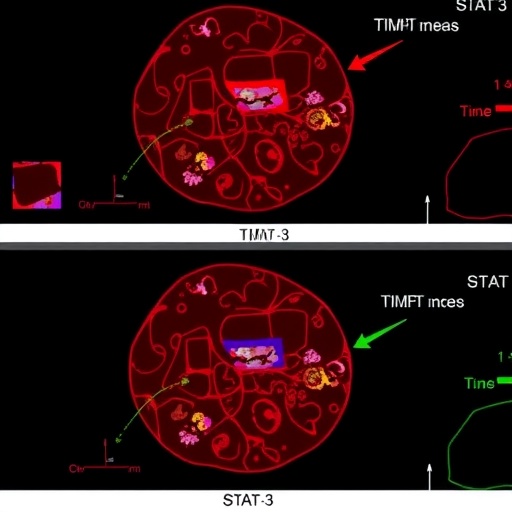In a groundbreaking study poised to reshape cancer immunotherapy, researchers have identified a promising therapeutic strategy that targets two pivotal molecular players within the tumor microenvironment: Tim-3 and STAT-3. This dual silencing approach has demonstrated significant tumor regression effects both in vitro and in ovo, potentially opening new avenues for combating some of the most aggressive cancer forms. The implications of this discovery resonate strongly within the scientific community, as it addresses key mechanisms behind immune evasion and tumor progression.
Cancer cells notoriously manipulate the immune system to facilitate their survival and proliferation, exploiting pathways that systematically dampen the body’s natural defenses. Central to these processes is the complex tumor microenvironment, where immune regulatory molecules like T-cell immunoglobulin and mucin-domain containing-3 (Tim-3) exert control over immune surveillance. While Tim-3’s function in immune regulation has been acknowledged, its intricate role in coordinating cellular signaling pathways responsible for tumor growth has remained elusive until now.
The latest research reveals that Tim-3 is not a solitary actor but is intricately linked with the signal transducer and activator of transcription 3 (STAT-3) pathway. STAT-3 is a transcription factor known for its pivotal role in cancer progression, particularly in promoting tumor cell proliferation, metastatic potential, and angiogenesis. Together, Tim-3 and STAT-3 form a regulatory axis that hampers antitumor immunity and fosters the malignant phenotype of cancer cells.
Exploiting this synergy, the study employed RNA interference techniques to concurrently silence Tim-3 and STAT-3, using small interfering RNA (siRNA) encapsulated in innovative chitosan lactate-based nanocarriers. This delivery system, previously developed by the research team, allowed efficient and targeted suppression of these genes within murine-derived malignant cell lines, notably 4T1 breast cancer and CT26 colon carcinoma cells, offering a potent and precise therapeutic tool.
The molecular intervention yielded compelling results. Post-transfection analyses exhibited a pronounced downregulation of both Tim-3 and STAT-3 gene expression. This genetic knockdown was associated with marked decreases in cancer cell viability and proliferation rates. Additionally, critical processes such as angiogenesis—the formation of new blood vessels that supply tumors with nutrients—and metastatic behaviors were notably impaired, which collectively subdued the aggressive nature of these tumor cells under laboratory conditions.
Further elevating the significance of these findings, the co-silencing strategy demonstrated tangible tumor regression effects in ovo, a relevant biological model that facilitates the observation of tumor growth in living systems. While in vitro studies provide critical mechanistic insights, in ovo models bridge the gap towards in vivo applications by reflecting more complex physiological interactions. The observed tumor shrinkage in this model underscores the potential translational value of this combined gene targeting.
Mechanistically, the intertwined regulatory functions of Tim-3 and STAT-3 offer insight into why single-factor suppression has been less efficacious historically. Tim-3 is a known checkpoint molecule that contributes to the exhaustion of T cells, blunting the immune system’s ability to attack tumors. Meanwhile, STAT-3 activation promotes survival signals within cancer cells and modulates immune components such as macrophages and dendritic cells to favor tumor tolerance. By simultaneously neutralizing both Tim-3 and STAT-3, the therapy effectively disrupts multiple pro-tumorigenic axes.
The chitosan lactate-based nano delivery system itself warrants attention. Nanocarrier-based RNAi therapy enhances the stability and cellular uptake of siRNA molecules, which otherwise face rapid degradation and poor internalization. Chitosan, a biocompatible and biodegradable polymer, provides a safe and efficient vehicle for gene silencing agents. The successful application of this nanocarrier in delivering siRNA against Tim-3 and STAT-3 demonstrates the evolving sophistication of nanomedicine approaches in targeting cancer.
While these promising preclinical outcomes signal a new frontier, the researchers emphasize the necessity for further studies involving more complex in vivo models. It is imperative to validate these concurrent silencing effects within whole organisms, where immune system interactions, pharmacokinetics, and potential side effects can be rigorously assessed. Such studies will determine the feasibility of translating this approach to human clinical trials.
Moreover, the combinatorial strategy of targeting multiple checkpoint molecules aligns with current trends in cancer immunotherapy, where single-agent regimens often encounter resistance or limited efficacy. This research complements and potentially enhances existing immune checkpoint inhibitors by providing a molecular blueprint for combination therapies that could overcome tumor immune escape mechanisms.
The implications extend beyond just breast and colon cancer models. Given that both Tim-3 and STAT-3 pathways are implicated in various cancer types, this therapeutic concept might catalyze broad-spectrum applications. Future investigations could tailor this siRNA-based dual targeting to patient-specific tumor profiles, heralding a precision-medicine approach to cancer care.
Amid an era where immune checkpoint blockade therapies have transformed oncological outcomes, the identification of Tim-3 as a co-regulator with STAT-3 presents a paradigm shift. Modulating this axis could potentiate anti-tumor immunity and dismantle the tumor-supportive microenvironment synergistically—elements critical to durable cancer remission.
In summary, the concurrent silencing of Tim-3 and STAT-3 by siRNA encapsulated in chitosan lactate nanocarriers reveals a potent strategy for impairing tumor growth, angiogenesis, and metastatic traits. This innovative approach heralds a promising therapeutic modality with the potential to augment current immunotherapies and deliver lasting oncological benefits.
As these findings continue to unfold, the cancer research community eagerly awaits clinical validations and eventual therapeutic innovations inspired by this dual silencing approach. The prospect of a more effective, multi-targeted cancer therapy leveraging immune modulation represents an exciting frontier in the ongoing battle against cancer.
Subject of Research: Cancer immunotherapy targeting Tim-3 and STAT-3 pathways to inhibit tumor progression.
Article Title: The concurrent silencing of Tim-3 and STAT-3 promotes tumor regression both in vitro and in ovo.
Article References:
Karami, R., Khodayari, S., Eshaghi, F. et al. The concurrent silencing of Tim-3 and STAT-3 promotes tumor regression both in vitro and in ovo. BMC Cancer 25, 1431 (2025). https://doi.org/10.1186/s12885-025-14830-5
Image Credits: Scienmag.com
DOI: https://doi.org/10.1186/s12885-025-14830-5




